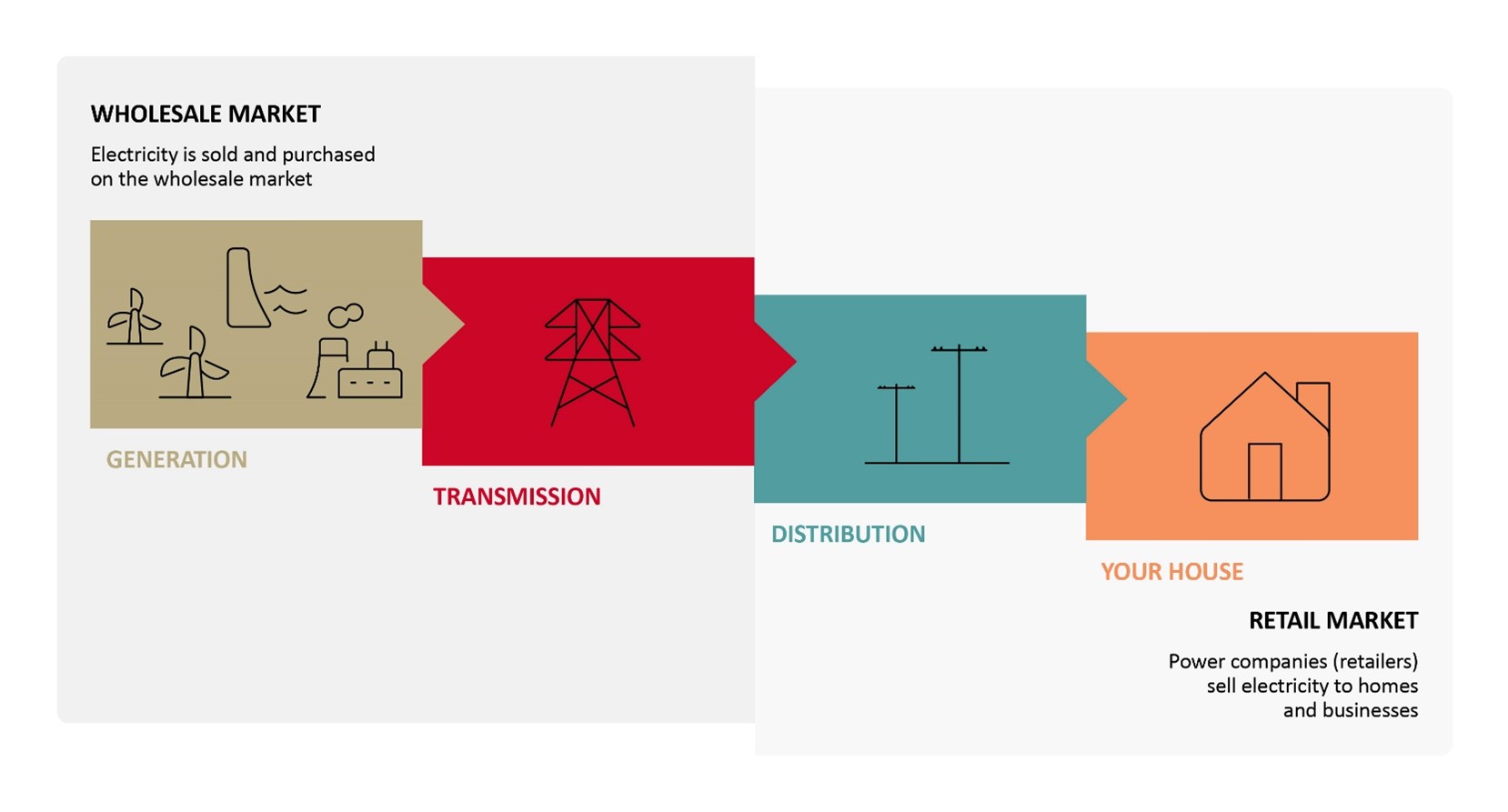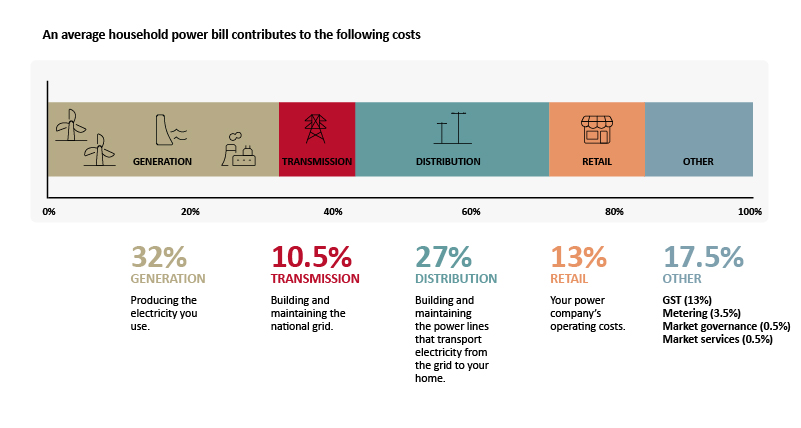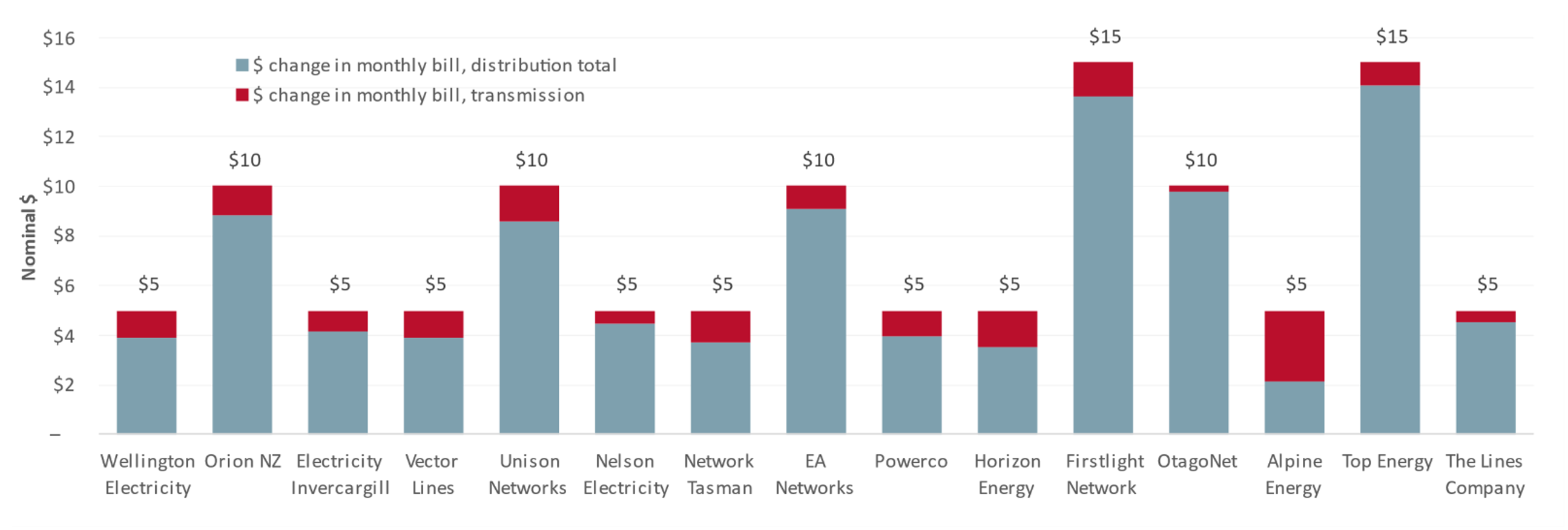- Home
- Regulated industries
- Electricity lines
- Understanding how changes to lines charges may impact your electricity bill
Electricity Lines and Transmission Charges: What are they, why are they changing and what does this mean for your electricity bill?
This page was updated2 days ago
Household electricity bills will increase in April 2025 by about $10 a month, on average. Increasing costs for material and labour, higher interest rates, and rising levels of investment in the electricity network combine to cause this increase. Investment in electricity assets is needed to ensure New Zealanders continue to receive a reliable, safe, and resilient electricity supply.
What is changing?
To protect consumers, the Commerce Commission limits the amount of revenue that Transpower and most local lines companies can earn for a set period (typically 5 years). New limits will apply from 1 April 2025, and will be higher due to the factors mentioned above.
When setting revenue limits, we focus on providing the right incentives so consumers benefit from appropriate investment in reliability and capacity for growth, and receive value for money. While higher revenue limits will mean consumers pay more, maintenance and improvements to the electricity network paid for now will help keep the lights on and delaying investment would lead to even higher prices later.
This short video provides an overview of the Commerce Commission’s decision for Transpower and local lines companies and why maintenance and improvements to the electricity network now will help keep the lights on in the future for consumers:
Our role in electricity regulation and the importance of investment
Our role in electricity regulation and the importance of investment - Te Reo
Getting electricity to where it needs to be: What is ‘transmission and distribution’?
Transpower owns and operates New Zealand’s national electricity transmission system, which transports electricity from where it is generated to cities, towns and some major industrial users.
Local lines companies own the distribution system that connects electricity from the transmission system to your home or business.
When we talk about the transmission and distribution component of an electricity bill, we are referring to the costs incurred by the electricity lines companies in owning and operating the power lines, power poles and other assets needed to transport electricity from where it is generated to your home or business. As shown below, this cost represents a portion of the electricity bill that you pay.

Electricity is generated from a variety of sources, before being transmitted across the national grid, then distributed locally and sold to you.

The increases discussed on this webpage only cover the transmission and distribution component. The other parts of your electricity bill (shown above) may also change over time. For further information about possible changes to the generation or retail parts of your bill, see the Electricity Authority’s website or contact your retailer directly.
Note, the percentages above are indicative only. Source: Electricity Authority.
What is the likely effect on households?
As explained above, for consumers to get the service they need, electricity bills will rise. We have provided estimates below of how much a household bill might rise as a result of our decisions.
It is important to note these numbers are estimates only and are intended to show the average scale of our decisions. The actual change in your bill will be different: you might pay more or less than average depending on how much electricity you use, how the lines company in your area sets its prices and the retailer pricing plan you have chosen. There are also other factors that affect the price you pay, such as generation and retail costs.
On average, household electricity bills will increase by about $10 per month ($120 annually) to pay for higher distribution and transmission costs, from 1 April 2025 for the first year of the period.
The average increase to household electricity bills will be different depending on where you live. Some regions will see average initial increases of around $10, while others will see average increases of $25 per month.
What is the likely increase for my region?
The graph below shows the estimated average bill increase per month relating to increases in distribution and transmission costs for each regulated lines company. There are various reasons for differences between local lines companies, but a significant factor is the number of consumers the costs are spread over.
If your local lines company is not shown below, then we do not regulate its revenue. There is one exception, Aurora Energy, is in the middle of a customised revenue path and therefore will not be affected by these decisions. The remaining local lines companies meet consumer ownership criteria in the Commerce Act and are exempt from revenue regulation. You will still have higher transmission charges and your local lines company may choose to increase its prices. Those that have regulated revenues cover approximately 80% of New Zealand households.
To find your local lines company, see the interactive map on Electricity Networks Aotearoa’s website. If you would like further information, or if you have questions about your bill or prices, please contact your retailer. You can also find a link to all local lines companies at the end of this page.

What are the likely changes for the remainder of the five-year period?
The estimated increases described above are for the first year of the new period (from April 2025 to April 2026). From 2026 to 2030, increases to your electricity bill are still likely, but will be smaller.
After the first year of the regulatory period, household electricity bills will increase on average by about $5 per month (or $60 annually) each year. At a regional level, the range is for an average increase between $5 to $15 per month (as shown in the graph below).

There may be other changes to regional electricity lines company prices during the next five years. We set the maximum revenue each lines company can recover. Some lines companies may decide to recover less revenue which would lead to lower bills in that region. In some areas, where significant, specific investment is needed, the business may apply to us to increase their revenue limit. If this were to occur, there will be information on the changes and how to have your say made available on our website and on the relevant electricity lines company’s website.
Why are these costs rising?
There are three key reasons for the upcoming estimated bill increases for the distribution and transmission component of your electricity bill:
- High inflation – Recent high inflation has led to significant increases to electricity lines companies’ costs.
- Interest rate increases – Similar to a fixed term mortgage, interest rates are fixed for a period of 5 years under our regulations. Interest rates are much higher now than when we last set revenue limits in 2019.
- Higher levels of investment – Transpower and local lines companies plan to spend more than they have previously to maintain the network and support growth. This is because assets built in the 1960s and 1970s need replacing, different resilience investments need to be considered in response to the increasing frequency of extreme weather such as Cyclone Gabrielle, and increased demand needs to be supported as New Zealand’s population grows and we rely more on electricity as we switch away from fossil fuels.
For example, this is approximately how much each driver described above has contributed to the increases for local lines companies:

What is the Commission doing to help with price rises?
The Commission aims to help ensure consumers receive a safe, reliable and resilient electricity network that meets their needs at a reasonable cost. To help ensure costs are reasonable, we review lines company spending forecasts before deciding how much expenditure to allow. We have limited the increase in their revenue as some costs or investments are uncertain and we have concerns that the industry may not be collectively able to deliver an increase in investment in the next 5 years. We have also limited the initial increase in prices, with a gradual increase over time.
Where to find additional help
- If you are struggling to pay your power bill, reach out to your retailer. Many retailers have options to help you with your payments. If they are unaware that you are finding it difficult to pay each electricity bill, they do not know to offer you that assistance.
- For free financial and budgeting advice, contact MoneyTalks. | www.moneytalks.co.nz or 0800 345 123.
- Visit Powerswitch: Powerswitch is a free service run by Consumer NZ which can help you find the power company and pricing plan that is best for you and help you to switch. | www.powerswitch.org.nz
- If you were on a low user charge pricing plan, you may be entitled to a one-off payment to help with the upcoming transition away from that policy. See Consumer NZ’s website for more information.
- Utilities Disputes: If you have an issue or problem with your electricity or gas supplier you can contact Utilities Disputes Ltd. They offer a free, independent dispute resolution service for consumers. They can look into most complaints, including billing (but not the amount electricity retailers or local lines companies charge), disconnections, damaged property, property access issues and difficulties in switching companies. | www.utilitiesdisputes.co.nz or call 0800 22 33 40.
Where to find more information
For information directly from your local lines company
Local lines companies – with revenue limits set by us
- Top Energy
- Vector
- PowerCo

- Horizon Energy
- Firstlight Energy
- The Lines Company
- Unison Networks
- Wellington Electricity
- Nelson Electricity
- Network Tasman
- Orion
- Electricity Ashburton
- Alpine Energy
- Aurora Energy
- OtagoNet
- Electricity Invercargill
Local lines companies – without revenue limits set by us (ie, consumer owned)
For information from Transpower
For information from the Electricity Authority
Energy Efficiency and Conservation Authority
The Energy Efficiency and Conservation Authority, through Gen Less, provides advice on using less energy| https://genless.govt.nz/for-everyone/at-home/improve-energy-efficiency/save-energy-at-home/
Citizens Advice Bureau
Your local Citizens Advice Bureau can help you if you’re having problems with your power bill and want to understand what your rights and options are | www.cab.org.nz or call 0800 367 222
